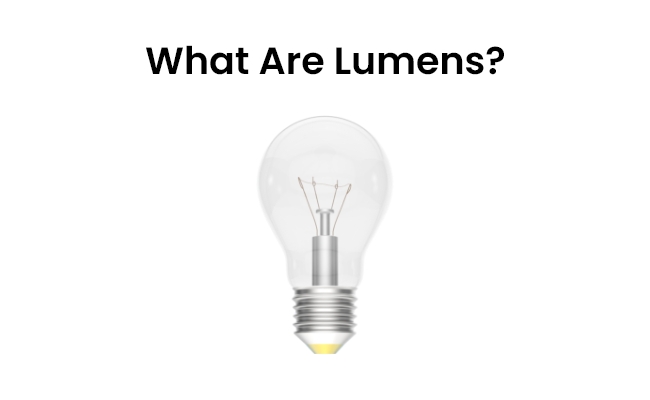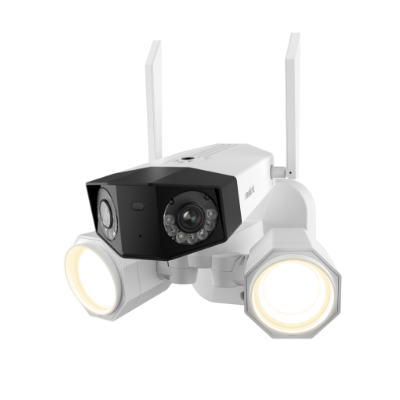What Are Lumens? A Simple Guide to Light Brightness

You might be wondering what are Lumens, right? The output of visible light in any light emitting source gets measured through the use of lumens. Light bulb and fixture selections depend on your lumen understanding because it sets the required illumination standards for tasks across various areas. This article uses a basic approach to explain lumens meaning and distinguish between lumen measurement and watt measurement.
What Are Lumens?
Lumens serve as a measurement term to determine the complete brightness output of light sources by counting all wavelengths and directions of light emission. The emission of visible light from a source happens at a definite rate to determine its complete brightness output.
For example, a 100-watt incandescent light bulb emits about 1600 lumens of light output. The light source generates 1600 total brightness units per second. The more lumens a light source emits, the brighter the illumination.
Lumens measure light output rather than light reception. In contrast, lux measures the amount of light reaching a surface area. For example, a desk surface directly under a light fixture would be exposed to more lux than the surrounding floor space.
What Are Lumens in Different Types of Lighting?
The meaning of lumens differs slightly depending on the type of light source. For example, what are lumens in light bulbs can’t be the same as in CFLs. Here is an overview:
What is a lumen in LED bulbs?
For LED bulbs, the lumens rating measures the total light output based on the LED component rating. Due to the directional nature of LEDs, some brightness gets absorbed by internal bulb components. Still, LED lumens give a standardized measure of comparing total light output.
What are lumens in CFLs?
In a CFL bulb, the lumens rating indicates the total initial light output based on the components within the spiral tube. Since CFL output declines over the bulb's lifetime, the listed lumens indicate the starting maximum brightness when new. The actual brightness will drop by around 10-20% by the time you replace an old CFL.
What are lumens in a flashlight?
Flashlights focus LED or incandescent bulbs into a tight, directed beam. The lumens measure the total emittance from the bulb and reflector that gets concentrated into the flashlight beam. More lumens translates to increased beam intensity.
What are lumens in incandescent bulbs?
Standard incandescent bulbs gain their lumen rating directly from their wattage value through established industrial calculations. Standard household incandescent bulbs generate light outputs from 800 to 2600 lumens that correspond to 40W to 150W. The lumens serve as the main factor that controls the inside bulb brightness.
What are lumens in floodlight camera?
In floodlights for security cameras, lumens also measure the brightness of the light emitted. The higher the lumens, the brighter the light. Floodlights enhance camera footage quality, especially at night. For example, Reolink Floodlight has 1800 lumen, which is bright enough for or large outdoor areas, parking lots, or wide surveillance zones.
4K WiFi Camera with Floodlights
Dual Lens, 5GHz/2.4GHz WiFi, 180° Wide-Angle Panorama, Person/Vehicle Detection
Lumens Chart
Standard incandescent bulbs, along with their equivalent LED versions, share identical lumen ratings. LEDs require minimal energy to generate the same amount of brightness as traditional lighting products. The combination of halogen and floodlight bulbs reaches higher lumens through increased wattage usage.
Below, you will find a chart that presents the typical lumens ratings of standard household light bulbs.
How Many Lumens Do You Need?
Lighting choice depends heavily on the installation location as well as planned activities in that space. The recommended lumens for various spaces fall under the following guidelines:
- Bathrooms - The illumination in bathrooms must be bright with no shadow areas because people use bathrooms to apply makeup and groom themselves. A suitable range of lumens should be between 3000 and 6000. Moreover, vanity strip lighting works well.
- Bedrooms - Gentle ambient and task lighting is ideal for bedrooms. Bedrooms can have layered lighting with switches ranging from 500 to 3000 lumens.
- Dining Rooms - Central chandeliers and sconces should emit around 2000 to 4000 lumens over the table area. Moreover, wall art lighting can be much lower, around 600 lumens.
- Garages - For workbench areas of garages, aim for around 4000 to 8000 lumens depending on the tasks. Fluorescent shop lights work well to distribute glare-free illumination.
- Hallways - Halls mainly need ambient fill lighting on the ceiling ranging between 400 and 2000 lumens, depending on length and function.
How to Pick the Right Lumens Based on Usage?
Here are some tips on choosing appropriate brightness lumens levels based on common lighting needs:
- For ambient ceiling or wall fixtures, stay between 2000-4000 lumens for most living spaces. Try to size the wattage and lumens to the room's dimensions.
- For task desk lighting, look at 3000-6000 lumens. Bounce off white ceilings rather than point down.
- Pick flood or spot LED bulbs ranging from 1000-4000 lumens for display cabinets, wall art, and shelves to highlight collectibles.
- For outdoor spotlights, start with a 2000-4000 lumen bulb. You can look for higher for highlighting architectural features or safety.
- For workbench lighting, use long LED or fluorescent strip lighting around 4000-8000 lumens.
Lumens vs Watts: What's the Difference?
Lumens relate to visible brightness coming from a light source, while watts refer to electrical power consumption. Here are the main differences:
- Lumens - A Measure of total light output across all wavelengths and directions
- Watts - Measure of electric power consumption rate
A direct relationship between incandescent bulb wattage and lumen output used to exist before the advent of LED technology. A 100-watt bulb produces around 1600 lumens. LEDs operate with 15 watts to produce the same brightness output that previously required 100 watts.
The lumens value should be your main consideration during light bulb purchases because it shows actual visible brightness across all bulb types. LEDs use less energy yet their dimness should not be determined solely by energy consumption. The comparison of lumens will help you find bulbs that deliver adequate brightness.
Higher wattage equals more power consumption. But watts alone won't indicate how bright a light bulb appears. Always check lumens rather than judging by watts or bulb type.
FAQs
Does higher lumens mean brighter?
Yes, higher lumens directly translates to increased visible brightness, regardless of light source. Two 1000-lumen bulbs emit the same total light output. So choose higher-lumen fixtures to increase illumination.
Is 1000 lumens very bright?
Not necessarily. As an approximate reference, a standard 100-watt incandescent bulb emits about 1600 lumens. The 1,000-lumen output corresponds to about 75% of standard household bulb intensity. When installed in a small bathroom the brightness of 1000 lumens can effectively fill the entire space. Living rooms together with porches typically perceive this light intensity as moderate.
What does 2000 lumens mean?
A light emitting 2000 lumens provides 125% more brightness than illumination from standard incandescent bulbs. Lamps of smaller sizes are characterized as high in intensity when they provide 2000 lumens of brightness. A ceiling light with 2000 lumens can provide sufficient eye-friendly illumination through rooms below 250 square feet.
Conclusion
Lumens provide you with a quantitative method to determine the brightness level between various light sources. The selection of lumens for home or workplace lighting should depend on space dimensions as well as requirements for specific tasks.
How much experience do you have regarding the selection of lighting through lumens? Have you identified any other simple methods for using Lumens in your practice? Share your thoughts below!
Search
Subscribe for the Latest Updates
Security insights & offers right into your inbox

